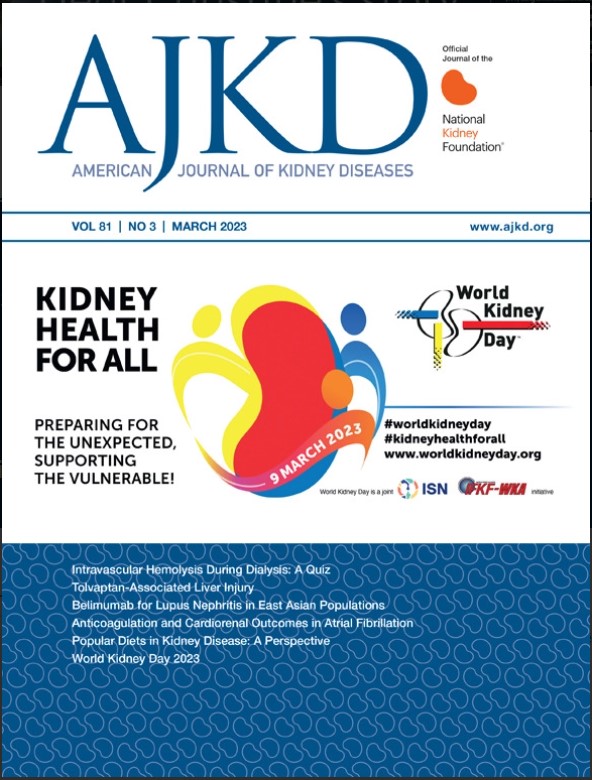急性失代偿性心力衰竭患者容量超载与肾功能结局的关系
IF 8.2
1区 医学
Q1 UROLOGY & NEPHROLOGY
引用次数: 0
摘要
理由与目的:肾小球滤过率(eGFR)评估肾功能降低是失代偿性心力衰竭(ADHF)患者不良结局的一个重要危险因素。然而,容量过载是eGFR下降的危险因素的证据并不一致。本研究考察了ADHF成人患者的这种关联。研究设计:回顾性观察性研究。背景和参与者:2015年至2021年间,因ADHF初步诊断需要右心导管而入住第四医院的成年患者。暴露:初始中心静脉压(CVP),肺毛细血管楔压(PCWP), CVP和PCWP的变化。结果:开始CVP和/或PCWP监测时的EGFR,院内EGFR斜率,以及到2022年3月开始透析。分析方法:限制三次样条和线性混合模型来检验CVP和PCWP与基线eGFR和院内eGFR斜率的关系。采用Cox比例风险回归模型检验CVP、PCWP以及CVP和PCWP的变化与透析开始的关系。敏感性分析将死亡视为一种竞争风险。结果:在753例患者中,较高的CVP和PCWP与较低的eGFR (β [95%CI]: -5.01[-6.68, -3.35]和-2.84 [-4.55,-1.13]ml/min/1.73m2 /周(CVP和PCWP升高1 SD分别为-1.13[-1.57,-0.69]和-0.59 [-1.02,-0.15]ml/min/1.73m2 /周)及较低的院内eGFR斜率(升高1 SD分别为-1.13[-1.57,-0.69]和-0.59 [-1.02,-0.15]ml/min/1.73m2 /周)显著相关。中位数为33个月(IQR为13,58),62例(8.2%)需要透析,264例(35.1%)死亡。较高的CVP和PCWP与透析风险增加相关:每升高1 SD CVP的aHR (95%CI)为1.49 (1.17,1.90),PCWP为1.30(1.04,1.62)。当将透析前死亡视为竞争风险时,相关关系保持一致。CVP和PCWP的变化与同时评估的eGFR或透析风险无关。局限性:观察性设计。结论:容量超载与基线肾功能降低、eGFR下降和开始透析的风险增加有关。容量过载程度的变化与伴随的eGFR变化或随访期间透析风险无关。本文章由计算机程序翻译,如有差异,请以英文原文为准。
Association of Volume Overload With Kidney Function Outcomes Among Patients With Acute Decompensated Heart Failure
Rationale & Objective
Reduced kidney function, as evaluated by estimated glomerular filtration rate (eGFR), is a powerful risk factor for adverse outcomes among patients with acute decompensated heart failure (ADHF). However, evidence that volume overload is a risk factor for declines in eGFR has been inconsistent. This study examined this association among adults with ADHF.
Study Design
Retrospective observational study.
Setting & Participants
Adult patients admitted to a quaternary referral hospital for a primary diagnosis of ADHF requiring right heart catheterization between 2015 and 2021.
Exposure
Initial central venous pressure (CVP), pulmonary capillary wedge pressure (PCWP), and change in CVP and PCWP.
Outcome
The eGFR when CVP and/or PCWP monitoring began, in-hospital eGFR slope, and initiation of dialysis through March 2022.
Analytical Approach
Restricted cubic splines and linear mixed models to examine the association of CVP and PCWP with baseline eGFR and in-hospital eGFR slope. Cox proportional hazard regression models were used to examine the association of CVP, PCWP, and changes in CVP and PCWP with initiation of dialysis. Sensitivity analyses were performed treating death as a competing risk.
Results
Among 753 patients, higher CVP and PCWP were significantly associated with lower eGFR (β, −5.01 [95% CI, −6.68 to −3.35] and −2.84 [95% CI, −4.55 to −1.13] mL/min/1.73m2 per 1 SD higher CVP and PCWP, respectively) and lower in-hospital eGFR slope (β, −1.13 [95% CI, −1.57 to −0.69] and −0.59 [95% CI, −1.02 to −0.15] mL/min/1.73 m2/week per 1 SD higher). Over a median of 33 (IQR, 13-58) months, 62 patients (8.2%) required dialysis, and 264 patients (35.1%) died. Higher CVP and PCWP were associated with increased risk for dialysis: the adjusted HR per 1 SD higher CVP was 1.49 (95% CI, 1.17-1.90) and PCWP 1.30 (95% CI, 1.04-1.62). The associations remained consistent when treating death before dialysis as a competing risk. Change in CVP and PCWP were not associated with concomitantly assessed eGFR or risk of dialysis.
Limitations
Observational design.
Conclusions
Volume overload was associated with lower baseline kidney function, greater declines in eGFR, and increased risk of starting dialysis. Changes in the degree of volume overload were not associated with concomitantly assessed changes in eGFR or the risk of dialysis over follow-up.
Plain-Language Summary
Studies evaluating volume overload as a risk factor for kidney function decline have been inconsistent. This study included adult patients admitted to the hospital with acute heart failure (2015-2021) who required invasive monitoring of heart pressures. Statistical models analyzed how volume overload on both the right and left sides of the heart were associated with kidney outcomes, independent of other patient factors. Patients with greater volume overload had lower baseline kidney function, greater decline in kidney function during the hospitalization, and an increased risk of requiring dialysis over approximately 3 years of follow-up evaluation. However, changes in the degree of volume overload were not associated with changes in kidney function measured over the same period.
求助全文
通过发布文献求助,成功后即可免费获取论文全文。
去求助
来源期刊

American Journal of Kidney Diseases
医学-泌尿学与肾脏学
CiteScore
20.40
自引率
2.30%
发文量
732
审稿时长
3-8 weeks
期刊介绍:
The American Journal of Kidney Diseases (AJKD), the National Kidney Foundation's official journal, is globally recognized for its leadership in clinical nephrology content. Monthly, AJKD publishes original investigations on kidney diseases, hypertension, dialysis therapies, and kidney transplantation. Rigorous peer-review, statistical scrutiny, and a structured format characterize the publication process. Each issue includes case reports unveiling new diseases and potential therapeutic strategies.
 求助内容:
求助内容: 应助结果提醒方式:
应助结果提醒方式:


